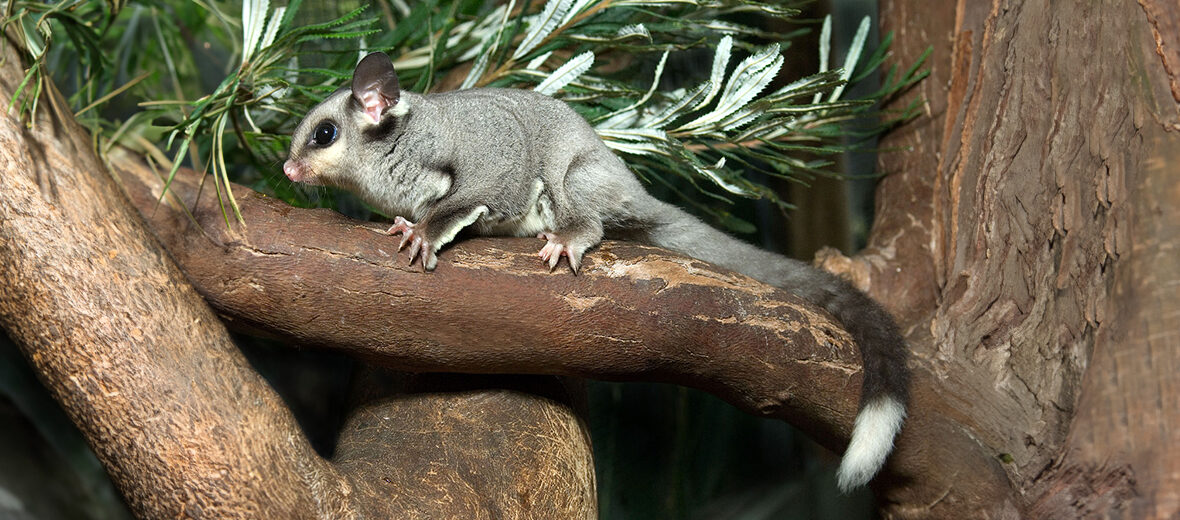
The squirrel glider is but 1 of the wrist-winged gliders from the genus Petaurus. They hail from eastern Australia. These critters bear a striking resemblance, albeit larger, to sugar gliders. Squirrel gliders face the threats of habitat loss and destruction at the hands of residential and commercial developments, farming, ranching, deforestation via the logging industry, fires, and fire suppression; and invasive species (a problem which has plagued Australia for decades), which can bring about disease and predation. However, these critters are abundant enough to be listed as Least Concern by the IUCN.
First the Stats…
Scientific name: Petaurus norfolcensis
Weight: Up to .5 lbs.
Length: Up to 9.06 inches, plus up to a 13 inch tail
Lifespan: Up to 6 years
Now on to the Facts!
1.) Their populations are, and have been, decreasing over the years.
2.) Like other Petaurus species, these critters are nocturnal (active at night).
3.) These gliders were thought to be extinct in South Australia since 1939 until a genetic test confirmed their existence in this region.
4.) They prefer to dwell in the dry sclerophyll forest (forests with trees & shrubs that have hard, leathery, evergreen leaves) and woodlands in southeastern Australia. However, in Queensland, they prefer to live in wetter eucalypt forest habitats.
5.) These marsupials (animals with a birth pouch) reside in small family groups of 1 male, 2 females, and their offspring.
But wait, there’s more on the squirrel glider!
6.) A group of gliders is called a colony.
7.) Like other gliders, they have a flying membrane (called a patagium) that extends from their 5th front toe to the back of their foot on both sides.
Did you know…?
These critters have the ability to glide up to 164 feet!
8.) When gliding, their prehensile tail acts as a rudder, allowing them to steer which direction they want to go.
9.) They don’t often glide in captivity.
10.) Breeding season lasts from June – January.
But wait, there’s still more on the squirrel glider!
11.) Females undergo up to an 18 day gestation (pregnancy) that yields up to 2 joeys.
12.) Joeys weigh just .0071 ounce at birth, and once born they immediately crawl into their mother’s marsupium (pouch).
Did you know…?
They obtain tree sap, primarily from eucalyptus or red bloodwood trees, by piercing the trunk of said trees with their teeth in order to cause sap to begin flowing. Then they simply lap it up.
13.) The joeys stay in the marsupium for up to 3 months and are completely weaned at up to 4 months. They are independent in up to 10 months.
14.) Fruit, tree sap, pollen, nectar, leaves, bark, and insects are all on the menu. This makes them gummivores, frugivores, folivores, and omnivores.
15.) These gliders are typically mistaken for flying squirrels of North America. However, they are not related in any way.
But wait, there’s still a tad more on the squirrel glider!
16.) Squirrel gliders have a prehensile tail (tail used as an additional appendage) that is used to grasp onto branches in trees. This feature is homologous (similar in position, structure, and evolutionary origin) to ringtail possums.
17.) Owls, goannas, lace monitors, cats, dogs, and foxes all prey on these critters.
18.) Some diseases these critters can be afflicted with are Giardiasis, caused from the parasitic Giardia duodenalis; neoplasm, which is a type of abnormal & excessive growth of tissue; Salmonellosis, which is a symptomatic infection caused by the bacteria Salmonella; Toxoplasmosis caused by the parasitic disease derived from Toxoplasma gondii; obesity; infectious bacterial diseases; and more.
Now a Short Squirrel Glider Video!
Be sure to share & comment below! Also, check out the Critter Science YouTube channel. Videos added regularly!
Want to suggest a critter for me to write about? Let me know here.
Some source material acquired from: Wikipedia & IUCN
Photo credit: Brisbane City Council




